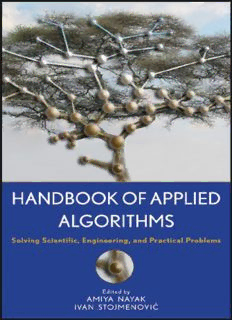Table Of ContentHANDBOOK OF
APPLIED ALGORITHMS
HANDBOOK OF
APPLIED ALGORITHMS
SOLVING SCIENTIFIC,
ENGINEERING AND
PRACTICAL PROBLEMS
Editedby
Amiya Nayak
SITE,UniversityofOttawa
Ottawa,Ontario,Canada
Ivan Stojmenovic´
EECE,UniversityofBirmingham,UK
A JOHN WILEY & SONS, INC., PUBLICATION
Copyright©2008byJohnWiley&Sons,Inc.Allrightsreserved.
PublishedbyJohnWiley&Sons,Inc.,Hoboken,NewJersey
PublishedsimultaneouslyinCanada
Nopartofthispublicationmaybereproduced,storedinaretrievalsystem,ortransmittedinanyformor
byanymeans,electronic,mechanical,photocopying,recording,scanning,orotherwise,exceptas
permittedunderSection107or108ofthe1976UnitedStatesCopyrightAct,withouteithertheprior
writtenpermissionofthePublisher,orauthorizationthroughpaymentoftheappropriateper-copyfeeto
theCopyrightClearanceCenter,Inc.,222RosewoodDrive,Danvers,MA01923,978-750-8400,fax
978-750-4470,oronthewebatwww.copyright.com.RequeststothePublisherforpermissionshouldbe
addressedtotehPermissionsDepartment,JohnWiley&Sons,Inc.,111RiverStreet,Hoboken,NJ
07030,201-748-6011,fax201-748-6008,oronlineathttp://www.wiley.com/go/permission.
LimitofLiability/DisclaimerofWarranty:Whilethepublisherandauthorhaveusedtheirbesteffortsin
preparingthisbook,theymakenorepresentationsorwarrantieswithrespecttotheaccuracyor
completenessofthecontentsofthisbookandspecificallydisclaimanyimpliedwarrantiesof
merchantabilityorfitnessforaparticularpurpose.Nowarrantymaybecreatedorextendedbysales
representativesorwrittensalesmaterials.Theadviceandstrategiescontainedhereinmaynotbesuitable
foryoursituation.Youshouldconsultwithaprofessionalwhereappropriate.Neitherthepublishernor
authorshallbeliableforanylossofprofitoranyothercommericaldamages,includingbutnotlimitedto
special,incidental,consequential,orotherdamages.
Forgeneralinformationonourotherproductsandservicesorfortechnicalsupport,pleasecontactour
CustomerCareDepartmentwithintheUnitedStatesat877-762-2974,outsidetheUnitedStatesat
317-572-3993orfax317-572-4002.
Wileyalsopublishesitsbooksinavarietyofelectronicformats.Somecontentthatappearsinprintmay
notbeavailableinelectronicformats.FormoreinformationaboutWileyproducts,visitourwebsiteat
www.wiley.com.
LibraryofCongressCataloging-in-PublicationData:
Handbookofappliedalgorithms:solvingscientific,engineering,andpractical
problem/editedbyAmiyaNayak&IvanStojmenovic.
p.cm.
ISBN978-0-470-04492-6
1. Computeralgorithms.I.Nayak,Amiya.II.Stojmenovic,Ivan.
QA76.9.A43H3532007
005.1–dc22
2007010253
PrintedintheUnitedStatesofAmerica
10987654321
CONTENTS
Preface vii
Abstracts xv
Contributors xxiii
1. GeneratingAllandRandomInstancesof
aCombinatorialObject 1
IvanStojmenovic
2. BacktrackingandIsomorph-FreeGenerationofPolyhexes 39
LuciaMouraandIvanStojmenovic
3. GraphTheoreticModelsinChemistryandMolecularBiology 85
DebraKnisleyandJeffKnisley
4. AlgorithmicMethodsfortheAnalysisof
GeneExpressionData 115
HongboXie,UrosMidic,SlobodanVucetic,andZoranObradovic
5. AlgorithmsofReaction–DiffusionComputing 147
AndrewAdamatzky
6. DataMiningAlgorithmsI:Clustering 177
DanA.Simovici
7. DataMiningAlgorithmsII:FrequentItemSets 219
DanA.Simovici
8. AlgorithmsforDataStreams 241
CamilDemetrescuandIreneFinocchi
v
vi CONTENTS
9. ApplyingEvolutionaryAlgorithmstoSolve
theAutomaticFrequencyPlanningProblem 271
FranciscoLuna,EnriqueAlba,AntonioJ.Nebro,PatrickMauroy,
andSalvadorPedraza
10. AlgorithmicGameTheoryandApplications 287
MariosMavronicolas,VickyPapadopoulou,andPaulSpirakis
11. AlgorithmsforReal-TimeObjectDetectioninImages 317
MilosStojmenovic
12. 2DShapeMeasuresforComputerVision 347
PaulL.RosinandJovisˇaZˇunic´
13. CryptographicAlgorithms 373
BimalRoyandAmiyaNayak
14. SecureCommunicationinDistributedSensor
Networks(DSN) 407
SubhamoyMaitraandBimalRoy
15. LocalizedTopologyControlAlgorithmsforAdHocand
SensorNetworks 439
HannesFreyandDavidSimplot-Ryl
16. ANovelAdmissionControlforMultimediaLEO
SatelliteNetworks 465
SyedR.Rizvi,StephanOlariu,andMonaE.Rizvi
17. ResilientRecursiveRoutinginCommunicationNetworks 485
CostasC.Constantinou,AlexanderS.Stepanenko,
TheodorosN.Arvanitis,KevinJ.Baughan,andBinLiu
18. RoutingAlgorithmsonWDMOpticalNetworks 509
Qian-PingGu
Index 535
PREFACE
Although vast activity exists, especially recent, the editors did not find any book
thattreatsappliedalgorithmsinacomprehensivemanner.Theeditorsdiscovereda
numberofgraduatecoursesincomputerscienceprogramswithtitlessuchas“Design
andAnalysisofAlgorithms,“CombinatorialAlgorithms”“EvolutionaryAlgorithms”
and“DiscreteMathematics.”However,whenglancingthroughthecoursecontents,
itappearsthattheyweredetachedfromthereal-worldapplications.Onthecontrary,
recently some graduate courses such as “Algorithms in Bioinformatics” emerged,
whichtreatonespecificapplicationareaforalgorithms.Othergraduatecoursesheav-
ilyusealgorithmsbutdonotmentionthemanywhereexplicitly.Examplesarecourses
oncomputervision,wirelessnetworks,sensornetworks,datamining,swarmintelli-
gence,andsoon.
Generally,itisrecognizedthatsoftwareverificationisanecessarystepinthedesign
of large commercial software packages. However, solving the problem itself in an
optimalmannerprecedessoftwareverification.Wastheproblemsolution(algorithm)
verified? One can verify software based on good and bad solutions. Why not start
withthedesignofefficientsolutionsintermsoftheirtimecomplexities,storage,and
evensimplicity?Oneneedsastrongbackgroundindesignandanalysisofalgorithms
tocomeupwithgoodsolutions.
This book is designed to bridge the gap between algorithmic theory and its ap-
plications. It should be the basis for a graduate course that will contain both basic
algorithmic, combinatorial and graph theoretical subjects, and their applications in
other disciplines and in practice. This direction will attract more graduate students
intosuchcourses.Thestudentsthemselvesarecurrentlydivided.Thosewithweak
math backgrounds currently avoid graduate courses with a theoretical orientation,
andviceversa.Itisexpectedthatthisbookwillprovideamuch-neededtextbookfor
graduatecoursesinalgorithmswithanorientationtowardtheirapplications.
Thisbookwillalsomakeanattempttobringtogetherresearchersindesignand
analysisofalgorithmsandresearchersthataresolvingpracticalproblems.Thesecom-
munitiesarecurrentlymostlyisolated.Practitioners,oreventheoreticalresearchers
from other disciplines, normally believe that they can solve problems themselves
with some brute force techniques. Those that do enter into different areas looking
for“applications”normallyendupwiththeoreticalassumptions,suitableforproving
theoremsanddesigningnewalgorithms,nothavingmuchrelevancefortheclaimed
application area. On the contrary, the algorithmic community is mostly engaged in
their own problems and remains detached from reality and applications. They can
rarelyanswersimplequestionsabouttheapplicationsoftheirresearch.Thisisvalid
vii
viii PREFACE
evenfortheexperimentalalgorithmscommunity.Thisbookshouldattractbothsides
andencouragecollaboration.Thecollaborationshouldleadtowardmodelingprob-
lemswithsufficientrealismfordesignofpracticalsolutions,alsoallowingasufficient
leveloftractability.
Thebookisintendedforresearchersandgraduatestudentsincomputerscienceand
researchersfromotherdisciplineslookingforhelpfromthealgorithmiccommunity.
The book is directed to both people in the area of algorithms, who are interested
in some applied and complementary aspects of their activity, and people that want
to approach and get a general view of this area. Applied algorithms are gaining
popularity,andatextbookisneededasareferencesourcefortheusebystudentsand
researchers.
Thisbookisanappropriateandtimelyforum,whereresearchersfromacademics
(bothwithandwithoutastrongbackgroundinalgorithms)andemergingindustryin
newapplicationareasforalgorithms(e.g.,sensornetworksandbioinformatics)learn
moreaboutthecurrenttrendsandbecomeawareofthepossiblenewapplicationsof
existingandnewalgorithms.Itisoftennotthematterofdesigningnewalgorithms,
butsimplytherecognitionthatcertainproblemshavebeenalreadysolvedefficiently.
Whatisneededisastartingreferencepointforsuchresources,whichthisbookcould
provide.
Handbook is based on a number of stand-alone chapters that together cover the
subjectmatterinacomprehensivemanner.Thebookseekstoprovideanopportunity
forresearchers,graduatestudents,andpractitionerstoexploretheapplicationofal-
gorithmsanddiscretemathematicsforsolvingscientific,engineering,andpractical
problems. The main direction of the book is to review various applied algorithms
andtheircurrently“hot”applicationareassuchascomputationalbiology,computa-
tionalchemistry,wirelessnetworks,andcomputervision.Italsocoversdatamining,
evolutionaryalgorithms,gametheory,andbasiccombinatorialalgorithmsandtheir
applications. Contributions are made by researchers from United States, Canada,
UnitedKingdom,Italy,Greece,Cyprus,France,Denmark,Spain,andIndia.
Recently, a number of application areas for algorithms have been emerging into
their own disciplines and communities. Examples are computational biology, com-
putationalchemistry,computationalphysics,sensornetworks,computervision,and
others. Sensor networks and computational biology are currently among the top
research priorities in the world. These fields have their own annual conferences
and books published. The algorithmic community also has its own set of annual
meetings, and journals devoted to algorithms. Apparently, it is hard to find a mix-
ture of the two communities. There are no conferences, journals, or even books
with mixed content, providing forum for establishing collaboration and providing
directions.
BRIEFOUTLINECONTENT
Thishandbookconsistsof18self-containedchapters.Theircontentwillbedescribed
brieflyhere.
PREFACE ix
Manypracticalproblemsrequireanexhaustivesearchthroughthesolutionspace,
whicharerepresentedascombinatorialstructuressuchaspermutations,combinations,
set partitions, integer partitions, and trees. All combinatorial objects of a certain
kind need to be generated to test all possible solutions. In some other problems, a
randomly generated object is needed, or an object with an approximately correct
ranking among all objects, without using large integers. Chapter 1 describes fast
algorithms for generating all objects, random object, or object with approximate
ranking,forbasictypesofcombinatorialobjects.
Chapter2presentsapplicationsofcombinatorialalgorithmsandgraphtheoryto
problemsinchemistry.Mostofthetechniquesusedarequitegeneral,applicableto
otherproblemsfromvariousfields.Theproblemofcellgrowthisoneoftheclassical
problems in combinatorics. Cells are of the same shape and are in the same plane,
without any overlap. The central problem in this chapter is the study of hexagonal
systems, which represent polyhexes or benzenoid hydrocarbons in chemistry. An
importantissueforenumerationandexhaustivegenerationisthenotionofisomorphic
or equivalent objects. Usually, we are interested in enumerating or generating only
onecopyofequivalentobjects,thatis,onlyonerepresentativefromeachisomorphism
class.Polygonalsystemsareconsidereddifferentiftheyhavedifferentshapes;their
orientationandlocationintheplanearenotimportant.Themainthemeinthischapter
isisomorph-freeexhaustivegenerationofpolygonalsystems,especiallypolyhexes.
In general, the main algorithmic framework employed for exhaustive generation is
backtracking,andseveraltechniqueshavebeendevelopedforhandlingisomorphism
issueswithinthisframework.Thischapterpresentsseveralofthesetechniquesand
theirapplicationtoexhaustivegenerationofhexagonalsystems.
Chapter3describessomegraph-theoreticmodelsinchemistryandmolecularbiol-
ogy.RNA,proteins,andotherstructuresaredescribedasgraphs.Thechapterdefines
and illustrates a number of important molecular descriptors and related concepts.
Algorithmsforpredictingbiologicalactivityofgivenmoleculeanditsstructureare
discussed. The ability to predict a molecule’s biological activity by computational
meanshasbecomemoreimportantasanever-increasingamountofbiologicalinfor-
mationisbeingmadeavailablebynewtechnologies.Annotatedproteinandnucleic
databasesandvastamountsofchemicaldatafromautomatedchemicalsynthesisand
high throughput screening require increasingly more sophisticated efforts. Finally,
thischapterdescribespopularmachinelearningtechniquessuchasneuralnetworks
andsupportvectormachines.
Amajorparadigmshiftinmolecularbiologyoccurredrecentlywiththeintroduc-
tionofgene-expressionmicroarraysthatmeasuretheexpressionlevelsofthousands
of genes at once. These comprehensive snapshots of gene activity can be used to
investigatemetabolicpathways,identifydrugtargets,andimprovediseasediagnosis.
However, the sheer amount of data obtained using the high throughput microarray
experimentsandthecomplexityoftheexistingrelevantbiologicalknowledgeisbe-
yondthescopeofmanualanalysis.Chapter4discussesthebioinformaticsalgorithms
thathelpanalyzesuchdataandareaveryvaluabletoolforbiomedicalscience.
Activities of contemporary society generate enormous amounts of data that are
used in decision-support processes. Many databases have current volumes in the
Description:Discover the benefits of applying algorithms to solve scientific, engineering, and practical problems Providing a combination of theory, algorithms, and simulations, Handbook of Applied Algorithms presents an all-encompassing treatment of applying algorithms and discrete mathematics to practical pro

